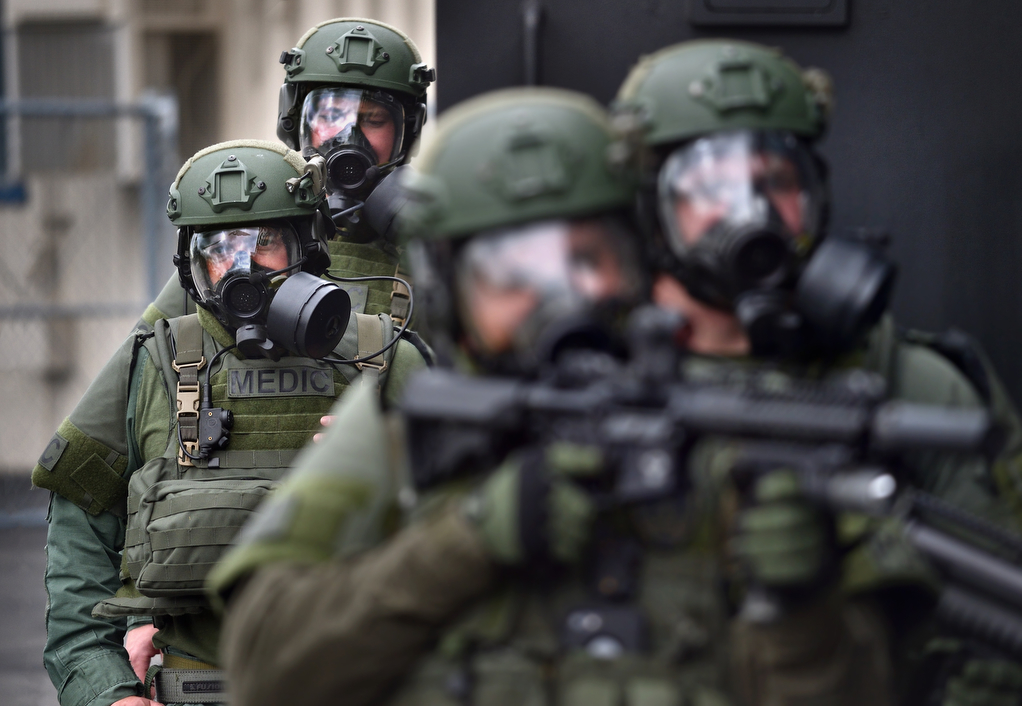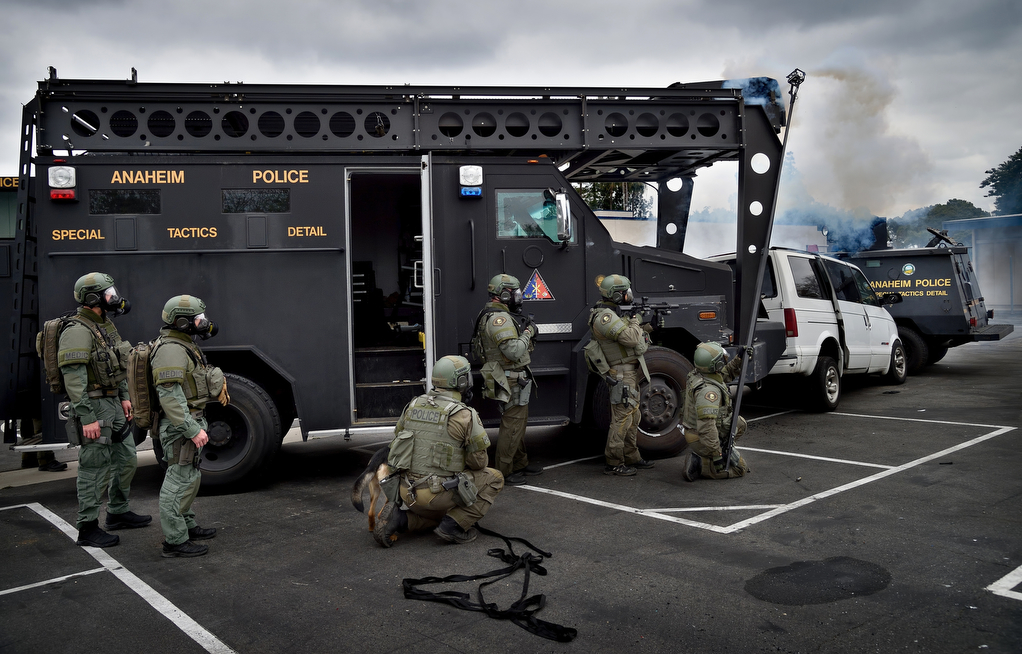They’re the guys who have your back when things go sideways.
For the Anaheim Police Department, they could be the difference between life or death, between tragedy and survival.
The Anaheim Fire & Rescue’s Special Weapons and Tactics (SWAT) team medics ride in the armored vehicle to all deployments, and they plan and prepare for any situation in which an officer, K9, or suspect might be injured.
Before deploying, they’ve mapped out the fastest route to the nearest trauma center, urgent care, and hospital. They are ready to provide medical aid immediately, and they’re prepared for action every time the team rolls out. At least two medics are included on every SWAT call.
“There’s a lot of mutual respect for both disciplines,” said Anaheim Police Sgt. Lou Correa, who oversees the SWAT team. “For the most part it’s very law enforcement-driven, but when injuries happen we have to flip that switch and get those medics into play quickly to assess the situation. Both roles are dependent on each other.”

Two Anaheim Fire & Rescue medics, left, stay as close during a drill as they would in a an actual incident at Roosevelt Elementary during a training.
Photo by Steven Georges/Behind the Badge
The team trains together, plans together, and deploys together, creating a cohesive unit prepared for all outcomes.
“We train for the worst and hope for the best,” said Jerod Blomberg of Anaheim Fire & Rescue Station 6, who’s been a SWAT medic for about four years.
Firefighter Paramedic Dustin Sola of Station 1 is one of the SWAT team’s newest members, along with Firefighter Paramedic Neil Powers of Station 8.
“I love my job as a firefighter. To me it’s the greatest job in the world,” Powers said. “And I get to do the awesome stuff police officers get to do. We get to be there with them and be their backup, in a sense, if anything goes wrong.”
The medics — who work voluntary shifts in addition to their regular Anaheim Fire & Rescue duties — ensure everyone on the team is hydrated, fed, and at their best physically.
Combining forces was a 10-year effort spearheaded by two Anaheim police lieutenants, said Captain Nick Colonelli of Station 1, who’s been with the team since the beginning, seven years ago.
“It’s a pretty well-oiled machine,” Colonelli said.
To join the SWAT team, medics apply for the special assignment, then must pass a physical and an interview. Not everyone succeeds.
But they tend to be modest about their role.
“The real stars are the SWAT guys that are getting shot at,” Powers said. “They’re in the limelight. We’re just here to support them.”
Calm during the storm
Powers and Captain Scott Mattis of Station 5 both have military backgrounds — an asset when working with SWAT. Powers has been with Anaheim Fire & Rescue for 17 years, is a corpsman and medic for a Marine Corps unit, and instructs tactical medicine for the military.
“The injuries you get would be a little bit different, in general,” Powers said.

Two Anaheim Fire & Rescue medics, left, stay close to the Anaheim Police Department Special Weapons and Tactics (SWAT) team members during a drill at Roosevelt Elementary.
Photo by Steven Georges/Behind the Badge
Tactical medics are able to perform more procedures than paramedics and require more training, he said. Mattis was an Army medic before joining Anaheim Fire & Rescue. He’s been on the SWAT team for five years.
“Just like being a paramedic, you have to be calm when everything around you is going crazy,” Powers said.
Thus far, the medical care required has been pretty routine. The medics have helped with minor scratches and lacerations sustained during training. They also assess suspects apprehended during warrant calls to make sure they don’t have any injuries, Blomberg said.
The medics have to be prepared for any situation, Colonelli said, “from somebody who’s been shot to somebody who sprained an ankle, or jumped through a window, or whatever.”
Medics and officers train together so that both sides have experience with all aspects of the job. For example, they visit the shooting range, are exposed to tear gas or pepper spray, and practice rappelling off buildings.
“Everybody on the team has a lot to think about, which is fun and why it’s so thrilling,” Colonelli said. “I like doing it because it is exciting but it’s nice to be the person who’s there to make sure these other officers can do their job safely. I like to be there but I don’t ever want to be needed.”
One of the first call-outs for the medics was serving a warrant on suspected gang members at a clandestine drug lab, Colonelli said. An alleged street gang occupied the first floor of an eight-plex apartment complex and had knocked down the walls to create one large room.
“They had an explosion because they’re criminals and not chemists,” Colonelli said. “It was loud enough that it blew out the windows.”
When a landlord approached the door days later, a man with an AK47 answered and told him to leave, he said.
“(The SWAT team) had to be in full hazmat suits,” Colonelli said. “It took a while to clear the place. When they finally came out they were all in tip-top shape, but one guy was not sweating and everybody else was.”
A medic treated the SWAT member and brought the issue to the sergeant’s attention. The man ended up admitted to a local hospital and was found to have an untreated medical condition.
“He wasn’t compensating as well to the heat environment and stress environment,” Colonelli said. “Ninety percent of what we do is keeping an eye on the team.”
Same skills, different purpose
Though both are public servants in citizens’ times of need, the fire and police departments have different goals and the public has a different perception of each calling.
“Our approach would be more cautious, more reactive. We find somebody who’s sick or injured and we go help them. Usually we don’t go in harm’s way,” Blomberg said. “With the SWAT team they try to take a more cautious approach, but there’s times they are going to be going into harm’s way.”
At a recent training, the team practiced forcible entry — a skill important to both professions. Anaheim Police Department has specialists for forcing doors, called breachers, and Anaheim Fire & Rescue uses similar tactics to get into buildings during calls.
“We would do it more than they do, but for different reasons,” Powers said. “We try to get in for fire and they try to get in to get suspects.”

Anaheim Fire & Rescue medics wear Anaheim Police Department Special Weapons and Tactics (SWAT) uniforms during a drill.
Photo by Steven Georges/Behind the Badge
Police SWAT team members and firefighters tend to have a similar personality profile as well, Powers said.
“You don’t really hear about them,” Powers said. “They don’t brag or talk about the team they’re on, they just get the job done…. We’re cut from the same cloth a lot of the time. Two sides of the same coin.”
Because the team’s officers and firefighters are spending more time together, they’ve developed closer relationships, which benefits both the departments and the citizens when both parties are out on emergency calls. The police contingent of the SWAT team has someone they trust handling their medical care.
“The relationship-building component of this is a great benefit to both fire and police,” Correa said. “There’s camaraderie there. It’s nice to go to the scene and see a familiar face and know what to expect. There’s a great benefit to having both disciplines united, which in the end means a better response.”
 Behind the Badge
Behind the Badge



